Recordings
Musicke & MIrth
Order CDs
20€/25CHF (postage included in EU and CH).
Please send us an email with the desired title, number of cds and your postal address.
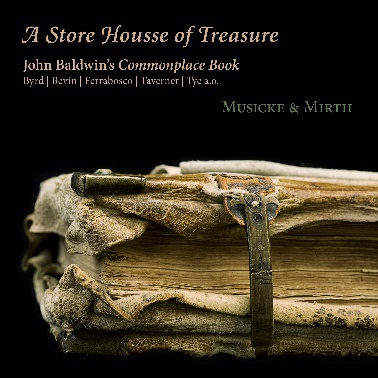
A Store Housse of Treasure
English music before 1600 of Byrd, Bevin and Baldwin Renaissance viol consort and Ulrike Hofbauer (soprano)
Artists: Ulrike Hofbauer, Grace Newcombe (Sopran), Julian Podger (Tenor), Breno Quindere (Bass), Irene Klein, Elizabeth Rumsey, Jane Achtman, Leonardo Bortolotto (Viola da Gamba)
John Baldwin and his Commonplace Book
„A store housse of treasure: this booke maye be saiede:- of songes most excelente and the beste that is made:- collected and chosen: out of the best autours :-
bothe stranger and englishe borne …“
John Baldwin, July 25 1591
A choirboy in a court chapel in England before 1600 was taught music theory and ensemble playing in conjunction with viol playing. Armed with this practical education, he performed a broad repertoire, encompassing church music, theatrical performances and evening entertainment for the feasts of wealthy citizens. The focus of our program “A store housse of treasure” is the singer, composer and music copyist John Baldwin, who compiled the repertoire performed in this musical environment in his socalled Commonplace Book. The previously unknown music contained in this manuscript covers a wide spectrum: humorous songs, rhythmically sophisticated instrumental pieces and profound motets.
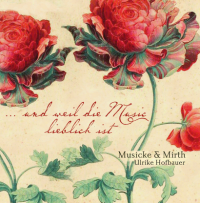
„… und weil die Music lieblich ist“
The viol consort Musicke&Mirth joins forces with versatile soprano Ulrike Hofbauer to perform this music for the first time in 400 years.
Artists: Ulrike Hofbauer (soprano), Jane Achtman, Irene Klein, Tore Eketorp and Elizabeth Rumsey (viols)
The four-part dance music is played by a four-part viol consort, the instruments used are copies of 16th century German instruments. Ulrike Hofbauer sings the soprano part of the five-part vocal pieces, the other parts are performed by the viol consort.
Ord. no.: 88985411952, total recording time: 66’51”, published bydeutsche harmonia mundi
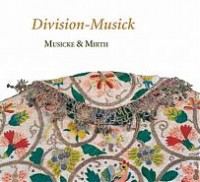
Division-Musick
The old english term „division“ refers to the dividing of notes, in modern English: diminution. Originally an improvised art, the art of division became very popular in England during the course of the seventeenth century, especially on the viol.
Artists: Amandine Beyer (violin), Jane Achtman and Irene Klein (viol), Johannes Strobl (virginal and organ)
The first composer to use the term „Division-Viol“ was William Lawes, who composed divisions on dance movements. During the course of the century, musicians did their best to outdo each other in improvising outrageous divisions. Christopher Simpson wrote his treatise „The Division Viol“, published in 1649, for the not so skilled player, giving very detailed instructions on how to play the division viol and how to learn how to improvise. For players in search of more artful fare, he gave following advice:„…if you desire Written Coppies of Divisions, made for Two or Three Parts…none hath done More in That kind, then the ever Famous, and most Excellent Composer, in all Sorts of Modern Musick, Mr. John Jenkins.“
Ord. no.: RAM 1204, total recording time: 64’46”, published by Ramee
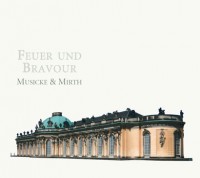
Feuer und Bravour
– Fire and Bravery –
Berlin’s libraries contain innumerable historic manuscripts. Studying the 18th century archives one can’t fail to notice the profusion of highly virtuosic works for the viola da gamba.
Artists: Jane Achtman and Irene Klein (viol), Rebeka Rusó (cello), Barbara Maria Willi (fortepiano and harpsichord)
How did such an accumulation of compositions arise for an instrument that – in other parts of Europe at that time – was already long past its zenith of success? Both Frederick II the Great (1712-1786) and his successor Frederick William II (1744–1797) were great musical benefactors. Almost every important late-18th-century gamba virtuoso came to play at the Berlin court during their reign. The greatest virtuoso of his time didn’t have to be summoned because he was already engaged at the court: Ludwig Christian Hesse (1716–1772). His presence led to the creation of many works for viola da gamba at the Berlin court, generally technically very demanding and idiomatically written, which are directly linked to Hesse.
Ord. no.: RAM 0803, total recording time: 68’22”, published by Ramee
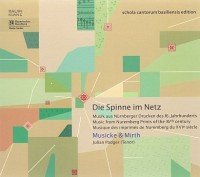
Die Spinne im Netz – Musik aus Nürnberger Drucken des 16. Jahrhunderts
– The Spider in the Web –
Music from Nuremberg music prints collected and printed by Hieronymus Formschneider und Johannes Petreius. Masterpieces by Alexander Agricola, arrangements of German folk songs by Ludwig Senfl and Heinrich Isaac, French ballads by Johannes Ghiselin and Jacobus Barbireau.
Artists: Julian Podger (tenor), Jane Achtman, Irene Klein and Silvia Tecard (viols), Wim Maeseele (lute)
„Die Spinne im Netz“ is the second CD in the series schola cantorum basiliensis edition. The CD series produces young aspiring musicians and ensembles, who have recieved their musical education at the Schola Cantorum Basiliensis.
Nürnberg – „Die Spinne im Netz- the spider in the web“ – was both a cultural and economical center of Northern Europe at the beginning of the 16th century. International music was appreciated by Nurembergs citizens, and the city was a commercial center of book printing. The first printers seriously involved in music printing were Hieronymus Formschneider and Johannes Petreius.
The ensemble Musicke&Mirth has chosen repertoire from various books published by these two printers in Nuremberg, among them wellknown masterpieces like „Caecox“ and „Tandernaken“ by Alexander Agricola, juxtaposing these pieces with lesserknown arrangements of German folk songs and ballads like „Elslein, liebstes Elselein mein“ and „Es wonet lieb bey liebe“ as well as French compositions and newer Italian musical forms. The ensemble is joined by the versatile and brilliant Tenor Julian Podger in interpreting these pieces.
Ord. no.: RK 2305, total recording time: 59’22”, published by Raumklang
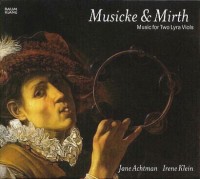
Musicke&Mirth – Music for Two Lyra Viols
What is a lyra viol? The term describes both a chordal style of playing the viol and a specific type of viol developed in England at the beginning of the seventeenth century.
Artists: Jane Achtman and Irene Klein (lyra viol), Silvia Tecardi (treble and bass viol)
At the turn of the century, probably due to continental influence, a chordal style of playing the viol became fashionable, joinig typical lute idioms with viol characteristics. Between 1601 and 1615 ten prints of music including or destined for the lyra viol were published, aimed both at the soloist and at the ensemble musician.
This versatile instrument could accompany light-hearted melodies with chords, play complex contrapuntal polyphony, could accompany singers and participate in large mixed ensembles. With the unusual capabilities of the lyra viol one could imitate the sound of a whole consort of viols on three or even only two instruments.
Both street and art music served as sources of inspiration for the composers. They often arranged well-known tunes for the instrument, those pieces are characterized by a playful attitude, imitating trumpets, nightingales, bagpipes and bells. The music for the instrument ranges from sorrowful pavans to lighthearted dances and “The Wild Goose Chase”, and our CD shows the whole colourfulness of the repertoire for the lyra viol.
Ord. no.: RK 9906, total recotding time: 54’03”, published by Raumklang